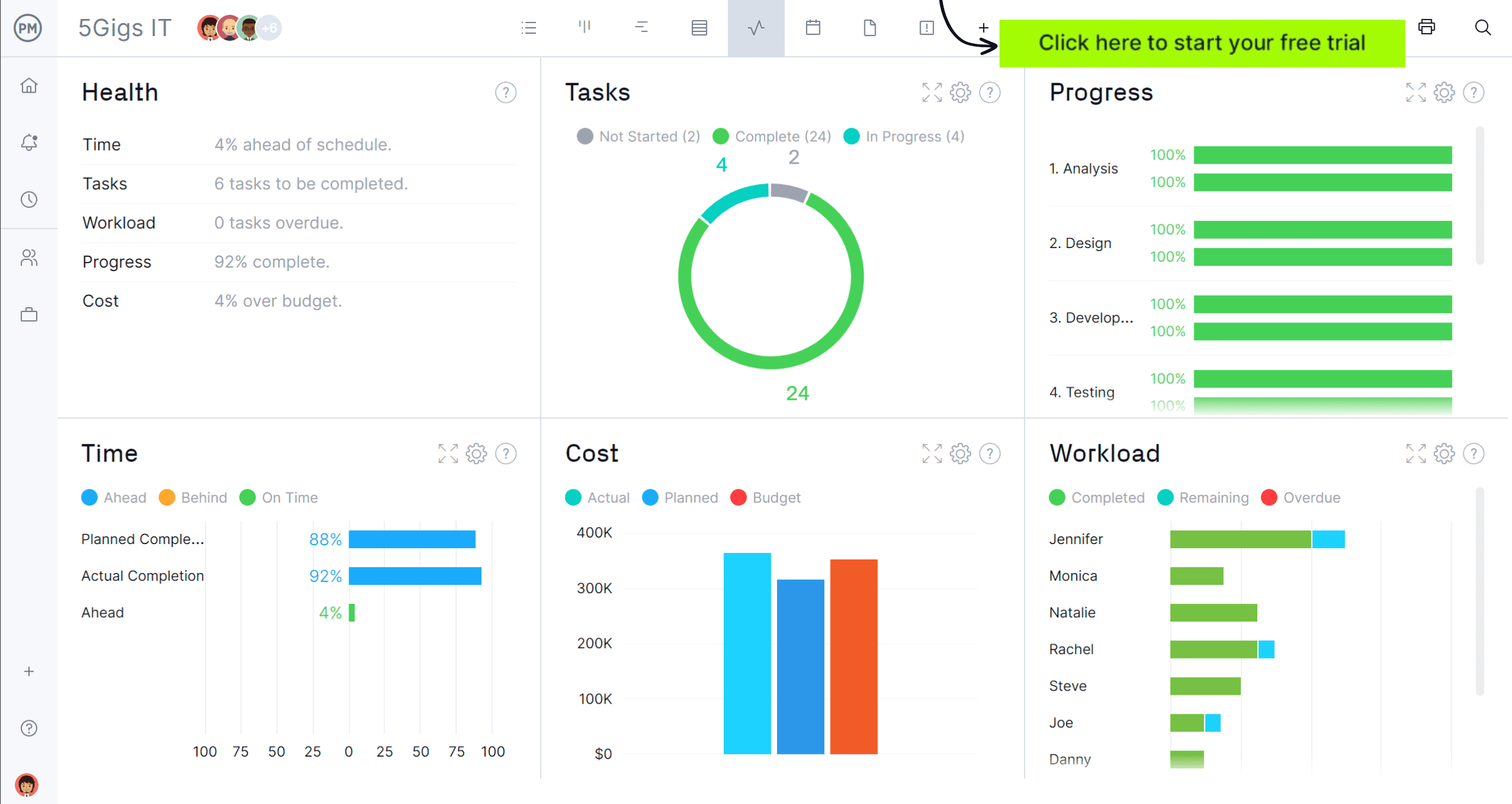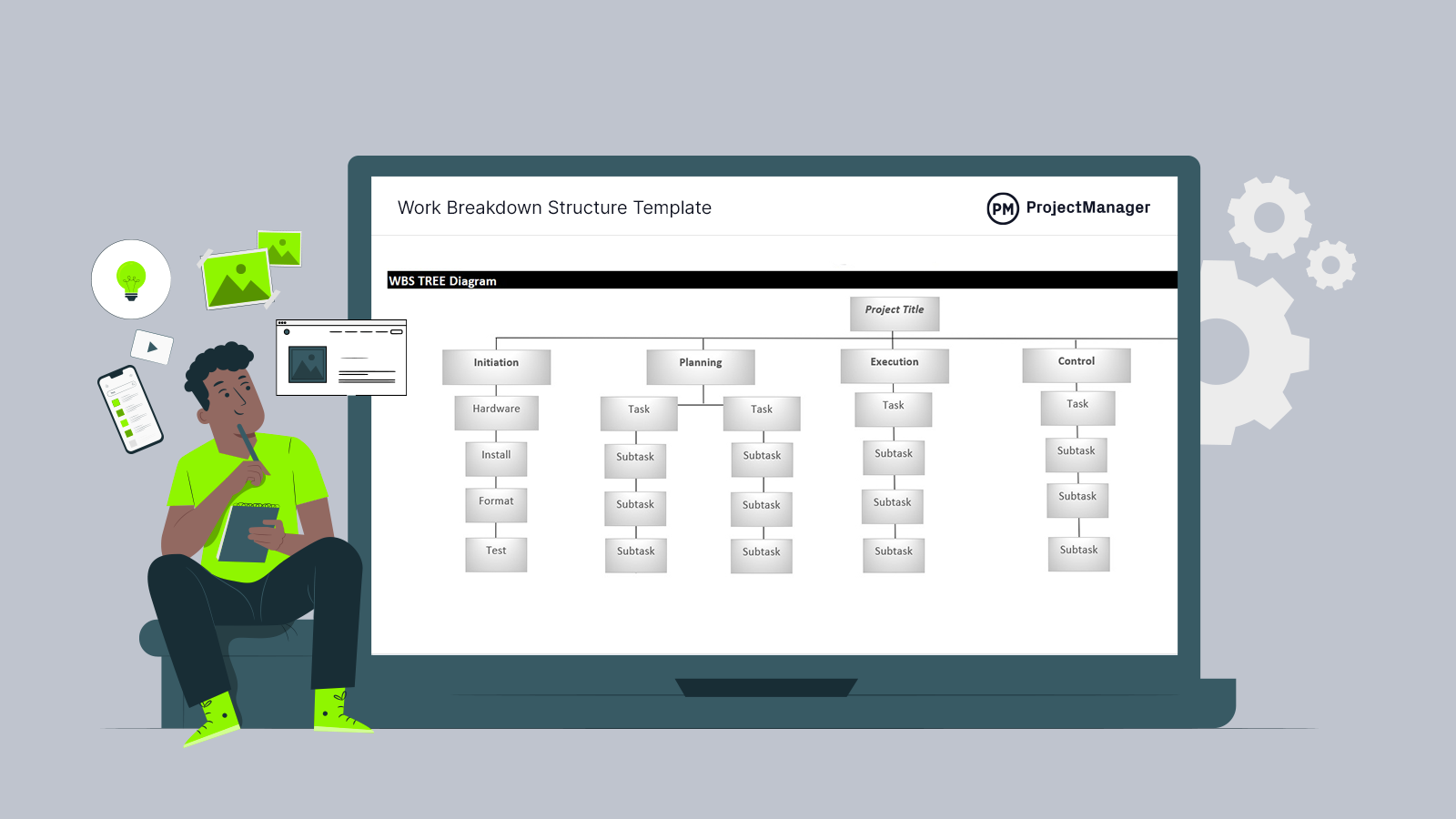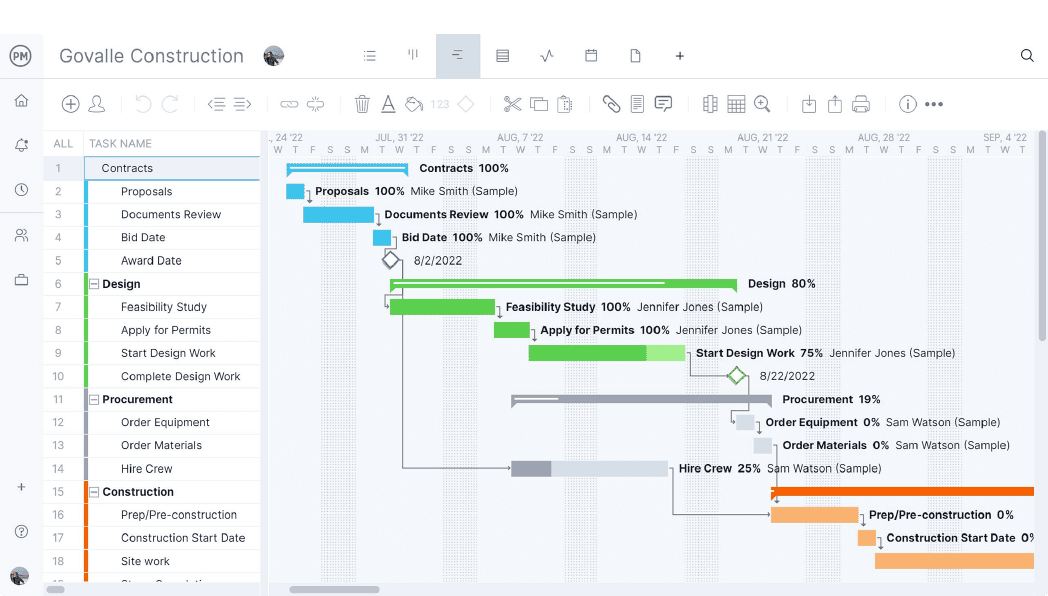Project management starts with a plan, one that is abstract until it’s executed. However, project execution is blind without a way to measure progress and performance. You first need a project baseline to capture that plan and compare it to your actual progress. This allows you to see where you are.
Once you’ve set a baseline, many techniques can help with performance management. Earned value management (EVM) is one such technique that, in a single integrated system, can accurately forecast problems so you can better manage project performance.
What Is Earned Value Management (EVM)?
As noted, EVM is a technique that project managers use to track the performance of their projects against project baselines. Often the progress of a project is thought of as ahead or behind schedule and over or under budget. However, what if you’re ahead of schedule, but costs are higher than your planned budget? Or, what if you’re behind schedule, but costs are lower than you first calculated?
Project management software can help you with variance analysis. ProjectManager has real-time dashboards that collect live data and automatically calculate variance analyses for you. The results are then displayed on colorful charts representing cost variance, schedule variance and more. Plus, there’s no setup required! Monitoring the six project metrics shown on the real-time dashboard is how you keep track of your project as it unfolds. Get started with ProjectManager for free today.

Knowing the earned value helps provide deeper information on your project. And when learning about earned value, it’s important to remember that there are three terms associated with it, each of which is slightly different.
- Earned Value Analysis (EVA): This project management technique is quantitative. It evaluates project performance by figuring out the likely results of the project. It does this by comparing the progress and budget of work planned to the actual costs.
- Earned Value Management (EVM): This methodology measures project performance with an integrated schedule and budget, which is based on the project work breakdown structure (WBS).
- Earned Value Management System (EVMS): This is the collection of tools, templates, processes and procedures that an organization uses to do EVM.
When to Use Earned Value Analysis in Project Management
There are several times when earned value analysis is beneficial for assessing project performance and progress and identifying variances against the planned schedule and budget. It can also help forecast future performance by estimating completion dates and costs based on current progress and trends.
Earned value analysis also helps find out how much budget has been spent relative to the work completed. This allows for better financial control in projects. It also highlights discrepancies between planned and actual performance, which allows project managers to quickly enact corrective action.
Complex projects benefit from using earned value analysis as it provides a comprehensive view of progress. This helps to manage dependencies and resource allocation effectively. Finally, managers can use earned value analysis when reporting to stakeholders on the project status.

Get your free
Work Breakdown Structure Template
Use this free Work Breakdown Structure Template to manage your projects better.
Get the Template
Who Participates in the Earned Value Analysis Process?
There are multiple stakeholders involved in the earned value analysis process. Let’s look at the key participants who are typically included when going through this process.
Project Manager
The project manager is responsible for overseeing the project and leads the earned value analysis process. They will interpret results and make strategic decisions based on that analysis. They also ensure that the collected data is accurate, communicate the results of the process to stakeholders and take actions to correct variances found.
Project Team Members
The project team is responsible for executing the project tasks, providing updates on progress and more. This provides input on actual progress and work completed. This helps gather data necessary for calculating earned value metrics.
EVM Specialists
An earned value management specialist is responsible for establishing baselines for the project’s scope, schedule and budget. They also collect and analyze data related to project performance, including actual costs, scheduled tasks and completed work, which helps deliver a more accurate analysis.
Earned Value Management Core Concepts
Earned value analysis based on a performance measurement baseline is how you can compare your project plan to your project execution. This allows project managers to answer three questions: Where were we, where are we now and where are we going? This requires accessing the following data points.
Planned Value (PV)
The planned value is where your project tasks should be at a specific point in the project schedule and cost estimation. These two values are the planned value of where you expect to be within the current reporting period. This value can either be cumulative or current. The former is the approved budget for planned activities that have to be done generally throughout the whole project. The latter is the approved budget for those planned activities being done over a specific period of the project, whether days, weeks or months.
Planned Value (PV) = % of project completed (planned) * Project Budget
Actual Cost (AC)
This is the actual cost of the work that’s been completed over a specific project period. The value refers to what has been spent, either cumulatively or currently. That is, either the actual cost for work done up to the point in which it is being calculated or over a given period of days, weeks or months.
Actual Cost (AC) = Actual costs to date
Earned Value (EV)
This is the quantification of the value of the work that’s been performed up to a certain date in the project. The cumulative earned value is the sum of the budget over the whole project up to the date of the calculation, while the current earned value is only carried out for a given period.
Earned Value = % of completed work * BAC (Budget at Completion)
How Do You Calculate Earned Value Management?
Now that we’ve learned about the foundational concepts of EVM, let’s learn how to calculate earned value management. To do so, we’ll use simple earned value management formulas, which are explained below.
Earned Value Management Formulas & Metrics
Some calculations can be done quickly and easily to execute EVM. EVM formulas can be divided into two groups: performance indexes and variance analysis formulas. Here they are:
Schedule Variance (SV)
The schedule variance is a way for project managers to figure out how much ahead or behind schedule, they are in the project. The formula to figure this out is as follows.
Schedule Variance (SV) = Earned value (EV) – Planned Value (PV)
Cost Variance (CV)
Cost variance is the difference between the actual cost of the project at that point it’s calculated compared against the planned budget cost for that period of time in the project plan. The formula is below.
Cost Variance (CV) = Earned value (EV) – Actual Cost (AC)
Schedule Performance Index (SPI)
The schedule performance index is a subset of EVM, which shows whether a project is ahead or behind schedule. It calculates the ratio of the performed work to the scheduled work. The formula for this is as follows.
Schedule Performance Index (SPI) = Earned value (EV) / Planned Value (PV)
Calculating the schedule performance index involves dividing the EV by the PV to measure progress achieved against where you expected to progress at a certain point. If you’ve come up with a value less than 1.0, it means that you’ve done less work than you projected for this point. While a value greater than 1.0 means you’ve completed more than was planned.
Cost Performance Index (CPI)
The cost performance index measures how efficient costs are in the project. It’s shown in a ratio of earned value to actual costs.
Cost Performance Index (CPI) = Earned Value (EV) / Actual Cost (AC)
For this calculation, you divide EV by the AC to measure the value of work completed against its actual cost. Again, if you reach a figure less than 1.0, your costs are higher than budgeted. A number higher than 1.0 means the costs are less than budgeted.
Estimated at Completion (EAC)
Estimated at completion is the current expectation of what the total costs will be for the project when it is done.
Estimated at Completion (EAC) = Budget at completion (BAC) / Cost performance index (CPI)
With this calculation, you divide the total project budget by the CPI value you figured out above.
Budget at Completion
This represents the total budget allocated for the project or a specific task at the time of project completion. To calculate this, first define the project scope, estimate costs, create a work breakdown structure and sum the costs. The formula is:
BAC = Total Estimated Costs for the Project
Estimate to Complete (ETC)
This represents the forecasted cost required to complete the remaining work of a project. The formula to calculate this is as follows:
ETC = BAC (Budget at Completion) – EV (Earned Value) / CPI (Cost Performance Index)
To-Complete Performance Index (TCPI)
This assesses the cost performance required to complete the remaining work of a project within a specified budget. The formula is:
TCIP= BAC (Budget at Completion) – EV (Earned Value) / BACK – AC (Actual Cost)
Once these metrics have been calculated using the earned value management formulas below, they can be visualized using an earned value management chart.
What Is an Earned Value Management Chart?
An earned value management chart is a graphical representation used to visualize and analyze the performance of a project in terms of cost and schedule. Key components of EVM charts included the planned value (PV), or the budget costs of work scheduled to be completed by a specific time, earned value (EV), budgeted costs of work that has actually been completed and actual cost (AC), costs incurred for the work completed by a specific time.
Key Benefits of Earned Value Management
It should be clear by now the importance of earned value management, but that doesn’t mean it hurts to outline some of the key benefits. Below are just a few, which are briefly defined.
Helps Keep Projects On Track
Project managers use EVM to find cost and schedule discrepancies early so that they can be quickly dealt with before causing the project to fall too far behind. This type of monitoring of time and cost is essential to keeping projects on track.
Holistic Project Performance Monitoring
Cost and time aren’t the only metrics that must be tracked to ensure the project is delivered successfully. EVM provides coverage of the entire project’s metrics, including scope, for more insightful decision-making.
Accurate Project Forecasting
Accurate estimates are critical to tracking cost and schedule outcomes. EVM helps to deliver better predictions of how much more time and money is going to be needed to finish the project. This helps to manage stakeholder expectations as well as prepare for future needs.
Disadvantages of Earned Value Management
EVM is a technique that you can use to manage and control your project, but EVM won’t solve everything. It doesn’t always work on your project and it’s not a magic bullet that can pierce all project problems. In fact, it has some pitfalls.
You can’t rely solely on earned value management. Remember, it’s merely calculating a single objective data point. The earned value of your project can change and can change fast. Naturally, cost and progress are seldom reflected in the actual project as they are when you’re executing the project. So, EVM acts as a safeguard and provides useful data. It’s best to make these calculations monthly or more frequently if your project is shorter in duration.
EVM Doesn’t Ensure Quality
There are some things that EVM doesn’t offer a window to view, such as customer satisfaction and the quality of the project. The project performance as it relates to important factors such as schedule and budget are tracked with EVM. However, a successful project is not one merely brought in on time and within budget. If your customer is unhappy or the project or service quality is poor, there’s a big problem regardless of meeting schedule and budget demands.
Without Accurate Data, EVM is Useless
If you don’t include all actual costs in your calculations, your results won’t accurately reflect the progress or performance of the project. If you’re using software that automatically makes these calculations you need to be doubly cautious, as it might overlook critical data and give you a misleading result.
EVM Needs Context
Finally, don’t just deliver the numbers to customers, stakeholders or whomever you’re reporting to—they need to know what those numbers mean and how you’re using them. Be clear in your language and avoid jargon. You know what you’re talking about, but it’s important that who you’re talking to understands as well. Don’t dumb it down, of course; just speak clearly and simply. Being able to effectively communicate EVM is as important as being able to calculate it.
Measure Performance With ProjectManager
Calculating performance is crucial to keeping projects on schedule and within budget, but what if you don’t have a calculator? Seriously, it’s a lot of work gathering all that data and calculating each equation. While important, it’s pulling you away from other important issues—and it’s so easily automated!
ProjectManager is award-winning software that automatically crunches data in real time to deliver the information you need and track the performance of your project. Every time a team member updates his or her status, that data is shared throughout our software, allowing you to easily make data-driven decisions.
Track Your Work With One-Click Reports
To get a deeper look at the data than the real-time dashboard can provide, use one-click reports. You can quickly generate status and portfolio reports as well as reports on cost, time, workload and more. Plus, you can easily filter each report to show only the information you’re interested in. Then share reports as PDF attachments or even print them out for stakeholder presentations and keep everyone updated.

If you do notice a discrepancy and want to dig deeper to discover what the issue is, we have a reporting feature that gets granular. You can filter the results of the report to show just the data you want. These reports can also be shared, so if you’re just tracking progress to present to your stakeholders, we have you covered.
Visualize The Project’s Progress
Because our software is constantly updating, you can keep track of your project from many points. For example, our online Gantt chart is great for planning and scheduling your project, but it also has a monitoring feature. The duration bar that links the start and end date to a task on the project timeline will reflect your team’s progress with sharing to indicate how close the task is to completion.

Our software works with your other earned value tools to give you a full picture of your project’s performance. Not only that, we offer a full plate of project management tools that all work together to make sure your projects are performing and meeting stakeholder expectations. Our software makes knowing your earned value simpler.
ProjectManager is online project management software that makes measuring progress and performing EVM easy. With its real-time dashboard, project metrics are instantly calculated with live data and delivered in easy-to-read charts and graphs that can be shared with a keystroke. Try it yourself with this free 30-day trial.

